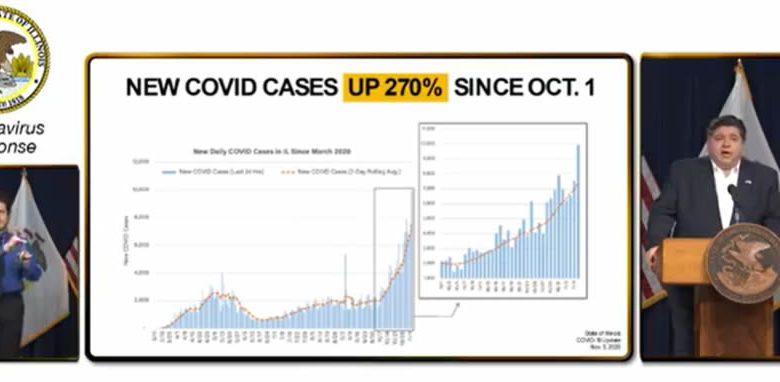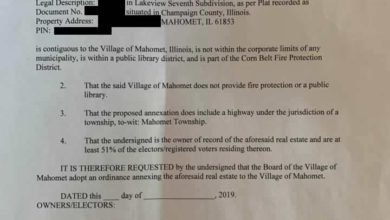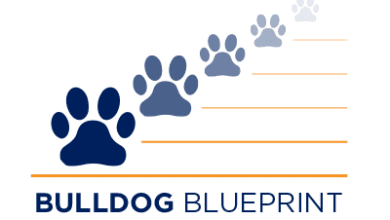New mitigations to come if Illinois COVID-19 trajectory does not change

On the same day that new COVID-19 positive cases hit 9,935 within 24 hours and the death toll passed 10,030 Illinois residents, Gov. JB Pritzker said that IDPH was looking at placing new mitigations throughout the state to curb the spread of the virus.
“Each day we are losing more and more of our neighbors to this virus,” Pritzker said. “That’s not a trend that’s going to turn around on its own. It’s up to us, all of us to do something to save the next family from tragedy because unfortunately it could easily be yours.
“To all those who have lost someone to this horrible invisible virus I am so sorry for your loss. I am so sorry for your grief. I’m so sorry that your personal tragedy is folded into this public one.”
Pritzker called the statewide increase of daily new COVID-19 cases “unsustainable.”
IDPH is looking at implementing everything from Phase 3 or Phase 2 mitigations if actions that lead towards the spread of COVID-19 are not practiced. Pritzker said he is not considering another stay-at-home order, though.
“What you do, what we all do, will determine how much worse the coming weeks will look,” he said.
In the last week, state case positivity rates have climbed from 6.9% to 9.1% on Nov. 5. The test positivity rate, which is used to trigger mitigations has climbed from 8.2% to 10.5% in the same time period.
“We’ve seen our case positivity rate in the state nearly triple (since the beginning of Oct.), as has been the case for weeks now,” he added.
Illinois is third in the nation in daily COVID-19 testing, reporting 8 million tests overall and more than 82,000 tests per day.
“That’s good news, and we’re continuing to build on that,” he said. “But at this point, the rate of growth in our positivity is far outpacing our growth in testing.”
Part of the problem, Pritzker said, is that people are finding they are positive of COVID-19 after being contacted by contact tracers or after finding out that they have been exposed.
“Don’t wait until you develop any symptoms, the earlier that you test, the more likely you can limit the spread of the virus to your family to your friends or your co workers across the state,” he said.
Region 6, the region Champaign and Vermilion counties are in, has the state’s lowest positivity average at 10-percent. Region 6 entered new mitigations, limiting indoor dining Monday.
The Northwest Region, Region 1, is at 15.8% and Region 7, including Kankakee County is at 13.4%.
Another concerning measure is that the state saw a rolling average of 2,700 COVID-19 patients in hospitals statewide whereas today that rolling average is up to 3,400, a 120% increase since October when the rolling average was 1,500 people in the hospital.
The October average of COVID-19 patients in the ICU was 360 per day but that number has doubled to 724 per day. Between Nov. 4 and 5, 97 people died of COVID-19.
“We’re seeing states and cities affected by this growing crisis, and they’re responding by rolling back their reopenings,” Pritzker said. “Over in Europe: France, England and Germany are rising at such a quick pace that they’re resorting to much more significant restrictions on all non-essential activities as they face case numbers and hospitalizations, rising at a tragic rate.
“Remember that Europe fared much better than the United States over the last five months. So when they impose those severe mitigations it’s an indication that the virus is raging out of control there. And we are heading in a similar direction.”
Locally, rural areas are seeing increases in COVID-19 cases. Area code 61853, including Mahomet, has been lingering between 20-30 active cases of COVID-19 for the last week.
Homer sits at 5 active cases currently, as the Heritage School District has reported a handful of positive cases since Oct. 23. Area code 61873, including St. Joseph currently has 17 active cases, a number that is lower than previous days when there were 24 active cases. Ogden has two active cases. Vermilion County had 49 positive cases on Oct. 31 and 31 on Nov. 2.
Champaign-Urbana Public Health Director said that people in a press conference last week that the community is following the masks and social distancing measures, but that residents are engaging in social gatherings like visiting grandparents or hosting a football watch party.
“Community transmission is so high, there’s a higher likelihood that you could get infected from that,” Pryde said. “Once it’s in the household, usually the entire household gets it. And because of the way the virus is where people don’t know for two days, then they go out they go back to their jobs and it just keeps spreading.”
Pritzker said that people throughout Illinois are wanting to do what they can to keep their families and friends safe, but that there are others don’t change their behavior, communities will experience a surge in hospitalizations.
“And in some areas of our state that will mean that you’ll run out of hospital beds and nurses and doctors who can treat you,” he said.
Pritzker said it is up to community leaders to enforce the mitigations that have been implemented by IDPH.
“If there was enforcement, if there were actual consequences for their actions at the local level; they’re supposed to enforce state laws, state regulations, state laws, that is their job. And when they don’t enforce them people die,” he said.




